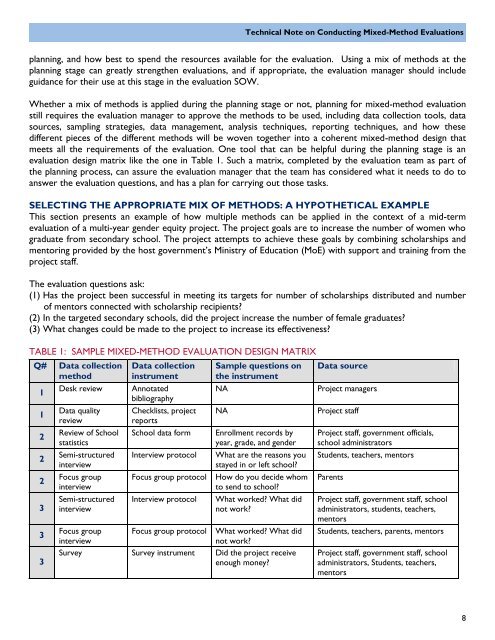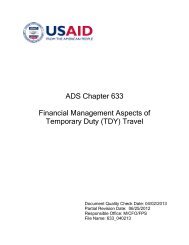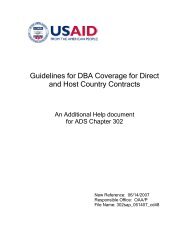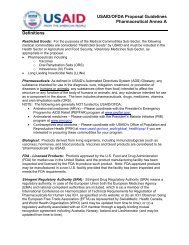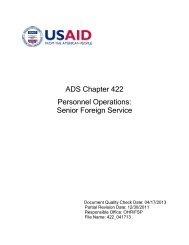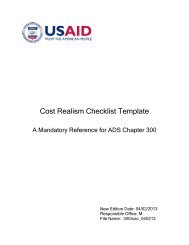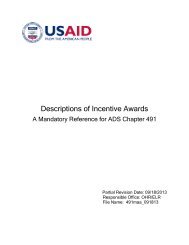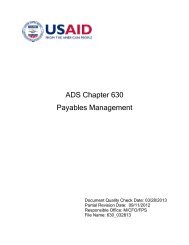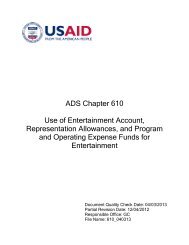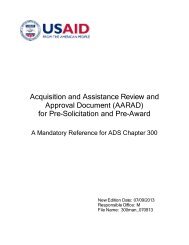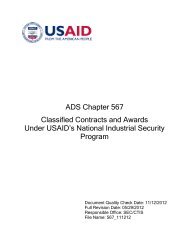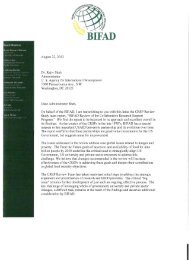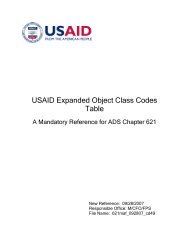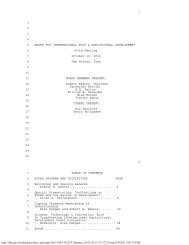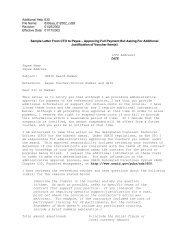Technical Note: Conducting Mixed Method Evaluations - usaid
Technical Note: Conducting Mixed Method Evaluations - usaid
Technical Note: Conducting Mixed Method Evaluations - usaid
You also want an ePaper? Increase the reach of your titles
YUMPU automatically turns print PDFs into web optimized ePapers that Google loves.
<strong>Technical</strong> <strong>Note</strong> on <strong>Conducting</strong> <strong>Mixed</strong>-<strong>Method</strong> <strong>Evaluations</strong><br />
planning, and how best to spend the resources available for the evaluation. Using a mix of methods at the<br />
planning stage can greatly strengthen evaluations, and if appropriate, the evaluation manager should include<br />
guidance for their use at this stage in the evaluation SOW.<br />
Whether a mix of methods is applied during the planning stage or not, planning for mixed-method evaluation<br />
still requires the evaluation manager to approve the methods to be used, including data collection tools, data<br />
sources, sampling strategies, data management, analysis techniques, reporting techniques, and how these<br />
different pieces of the different methods will be woven together into a coherent mixed-method design that<br />
meets all the requirements of the evaluation. One tool that can be helpful during the planning stage is an<br />
evaluation design matrix like the one in Table 1. Such a matrix, completed by the evaluation team as part of<br />
the planning process, can assure the evaluation manager that the team has considered what it needs to do to<br />
answer the evaluation questions, and has a plan for carrying out those tasks.<br />
SELECTING THE APPROPRIATE MIX OF METHODS: A HYPOTHETICAL EXAMPLE<br />
This section presents an example of how multiple methods can be applied in the context of a mid-term<br />
evaluation of a multi-year gender equity project. The project goals are to increase the number of women who<br />
graduate from secondary school. The project attempts to achieve these goals by combining scholarships and<br />
mentoring provided by the host government’s Ministry of Education (MoE) with support and training from the<br />
project staff.<br />
The evaluation questions ask:<br />
(1) Has the project been successful in meeting its targets for number of scholarships distributed and number<br />
of mentors connected with scholarship recipients?<br />
(2) In the targeted secondary schools, did the project increase the number of female graduates?<br />
(3) What changes could be made to the project to increase its effectiveness?<br />
TABLE 1: SAMPLE MIXED-METHOD EVALUATION DESIGN MATRIX<br />
Q# Data collection<br />
method<br />
Desk review<br />
1<br />
1<br />
2<br />
2<br />
2<br />
3<br />
3<br />
3<br />
Data quality<br />
review<br />
Review of School<br />
statistics<br />
Semi-structured<br />
interview<br />
Focus group<br />
interview<br />
Semi-structured<br />
interview<br />
Data collection<br />
instrument<br />
Annotated<br />
bibliography<br />
Checklists, project<br />
reports<br />
School data form<br />
Interview protocol<br />
Focus group protocol<br />
Interview protocol<br />
Sample questions on<br />
the instrument<br />
NA<br />
NA<br />
Enrollment records by<br />
year, grade, and gender<br />
What are the reasons you<br />
stayed in or left school?<br />
How do you decide whom<br />
to send to school?<br />
What worked? What did<br />
not work?<br />
Focus group<br />
interview<br />
Focus group protocol What worked? What did<br />
not work?<br />
Survey Survey instrument Did the project receive<br />
enough money?<br />
Data source<br />
Project managers<br />
Project staff<br />
Project staff, government officials,<br />
school administrators<br />
Students, teachers, mentors<br />
Parents<br />
Project staff, government staff, school<br />
administrators, students, teachers,<br />
mentors<br />
Students, teachers, parents, mentors<br />
Project staff, government staff, school<br />
administrators, Students, teachers,<br />
mentors<br />
8


